Elk range in forest and forest-edge habitat, feeding on grasses, plants, leaves, and bark. Male elk have large antlers which are shed each year. Males also engage in ritualized mating behaviors during the rut, including posturing, antler wrestling (sparring), and bugling, a loud series of vocalizations that establishes dominance over other males and attracts females.
Although they are native to North America and eastern Asia, they have adapted well to countries in which they have been introduced, including Argentina and New Zealand. Their great adaptability may threaten endemic species and ecosystems into which they have been introduced.
Elk are susceptible to a number of infectious diseases, some of which can be transmitted to livestock. Efforts to eliminate infectious diseases from elk populations, largely by vaccination, have had mixed success.
Some cultures revere the elk as a spiritual force. In parts of Asia, antlers and their velvet are used in traditional medicines. Elk are hunted as a game species. The meat is leaner and higher in protein than beef or chicken.[3]
It was long believed to be a subspecies of the European red deer (Cervus elaphus), but evidence from a number of mitochondrial DNA genetic studies beginning in 1998 show that the two are distinct species.[4][5][6][7] Key morphological differences that distinguish C. canadensis from C. elaphus are the former's wider rump patch and paler-hued antlers.[8]
Elk (male)
Elk (female)
Naming and etymology
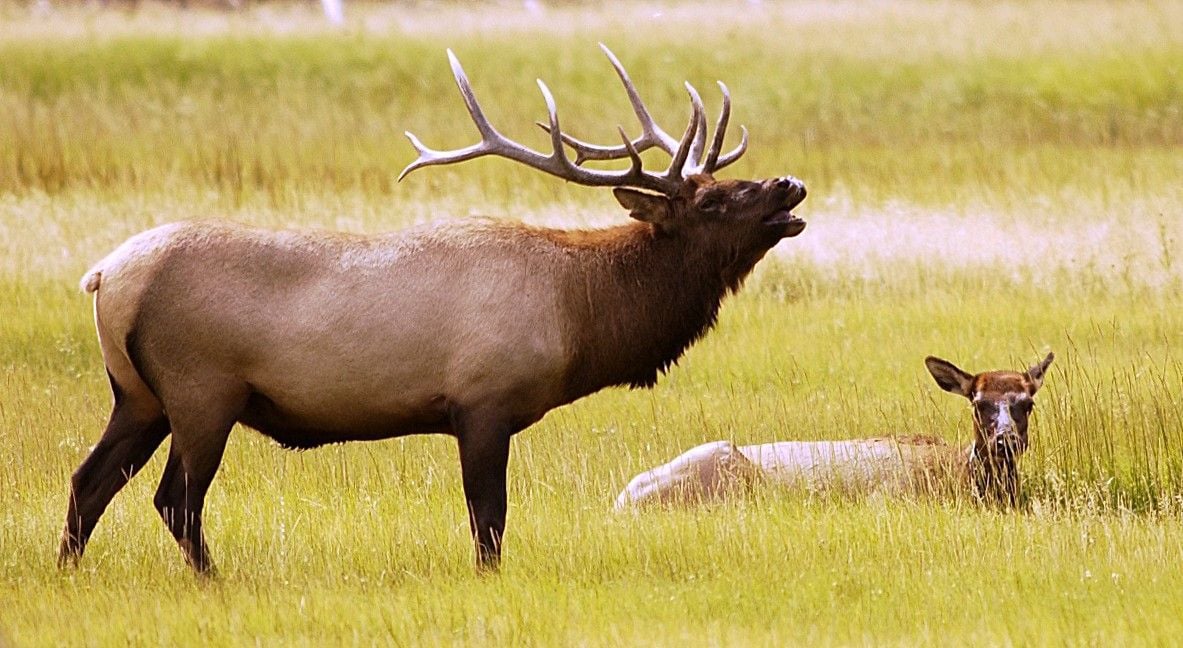
Early European explorers in North America, who were familiar with the smaller red deer of Europe, thought that the larger North American animal resembled a moose, and consequently gave it the name elk, which is the common European name for moose. The word elk is related to the Latin alces, Old Norse elgr, Scandinavian elg/älg and German Elch, all of which refer to the animal known in North America as the moose.[9]
The name wapiti is from the Shawnee and Cree word waapiti, meaning "white rump".[10] This name is used in particular for the Asian subspecies (Altai wapiti, Tian Shan wapiti, Manchurian wapiti and Alashan wapiti), because in Eurasia the name elk continues to be used for the moose.
Wapiti is also the preferred name for the species in New Zealand.
Asian subspecies are sometimes referred to as the maral, but this name applies primarily to the Caspian red deer (Cervus elaphus maral), a subspecies of red deer. There is a subspecies of elk in Mongolia called the Altai wapiti (Cervus canadensis sibiricus),[11] also known as the Altai maral.
Taxonomy
Elk crossing a rock face
Until recently, red deer and elk were considered to be one species, Cervus elaphus.[11][14] However, mitochondrial DNA studies, conducted on hundreds of samples in 2004 from red deer and elk subspecies as well as other species of the Cervus deer family, strongly indicate that elk, or wapiti, should be a distinct species, namely Cervus canadensis.[6] The previous classification had over a dozen subspecies under the C. elaphus species designation; DNA evidence concludes that elk are more closely related to Thorold's deer and even sika deer than they are to the red deer.[6] Elk and red deer produce fertile offspring in captivity, and the two species have freely inter-bred in New Zealand's Fiordland National Park, where the cross-bred animals have all but removed the pure elk blood from the area.[15]
Subspecies

There are numerous subspecies of elk described, with six from North America and four from Asia, although some taxonomists consider them different ecotypes or races of the same species (adapted to local environments through minor changes in appearance and behavior). Populations vary as to antler shape and size, body size, coloration and mating behavior. DNA investigations of the Eurasian subspecies revealed that phenotypic variation in antlers, mane and rump patch development are based on "climatic-related lifestyle factors".[16] Of the six subspecies of elk known to have inhabited North America in historical times, four remain, including the Roosevelt (C. canadensis roosevelti), tule (C. canadensis nannodes), Manitoban (C. canadensis manitobensis) and Rocky Mountain (C. canadensis nelsoni).[17] The eastern elk (C. canadensis canadensis) and Merriam's elk (C. canadensis merriami) subspecies have been extinct for at least a century.[18][19]
Four subspecies described in Asia include the Altai wapiti (C. canadensis sibiricus) and the Tianshan wapiti (C. canadensis songaricus). Two distinct subspecies found in China and Korea are the Manchurian wapiti (C. canadensis xanthopygus) and the Alashan wapitis (C. canadensis alashanicus). The Manchurian wapiti is darker and more reddish in coloration than the other populations. The Alashan wapiti of north central China is the smallest of all subspecies, has the lightest coloration and is the least studied.[15] Biologist Valerius Geist, who has written on the world's various deer species, holds that there are only three subspecies of elk. Geist recognizes the Manchurian and Alashan wapiti but places all other elk into C. canadensis canadensis, claiming that classification of the four surviving North American groups as subspecies is driven, at least partly, for political purposes to secure individualized conservation and protective measures for each of the surviving populations.[20]
Recent DNA studies suggest that there are no more than three or four subspecies of elk. All American forms aside from possibly the tule and Roosevelt elk seem to belong to one subspecies (Cervus canadensis canadensis). Even the Siberian elk (Cervus canadensis sibiricus) are more or less identical to the American forms and therefore may belong to this subspecies, too. However the Manchurian wapiti (Cervus canadensis xanthopygus) is clearly distinct from the Siberian forms, but not distinguishable from the Alashan wapiti. The Chinese forms MacNeill's deer, Kansu red deer, and Tibetan red deer belong also to the wapitis and were not distinguishable from each other by mitochondrial DNA studies.[6] These Chinese subspecies are sometimes treated as a distinct species, namely the Central Asian red deer (Cervus wallichi), which also includes the Kashmir stag.[21]
- Northern and American group
- Roosevelt elk (C. c. roosevelti)
- Tule elk (C. c. nannodes)
- Manitoban elk (C. c. manitobensis)
- Rocky Mountain elk (C. c. nelsoni)
- Eastern elk (C. c. canadensis; extinct)
- Merriam's elk (C. c. merriami; extinct)
- Eastern group
- Altai wapiti (C. c. sibiricus)
- Tian Shan wapiti (C. c. songaricus)
- Manchurian wapiti (C. c. xanthopygus)
- Alashan wapiti (C. c. alashanicus)
- Southern group (Central Asian red deer)
- MacNeill's deer (C. c. macneilli)
- Kansu red deer (C. c. kansuensis)
- Tibetan red deer (C. c. wallichii)
- Kashmir stag (C. c. hanglu)
Anatomy
A herd of Roosevelt elk
Elk are more than twice as heavy as mule deer and have a more reddish hue to their hair coloring, as well as large, buff-colored rump patches and smaller tails. Moose are larger and darker than elk; bulls have distinctively different antlers. Elk gather in herds, while moose are solitary. Elk cows average 225 to 241 kg (496 to 531 lb), stand 1.3 m (4.3 ft) at the shoulder, and are 2.1 m (6.9 ft) from nose to tail. Bulls are some 40% larger than cows at maturity, weighing an average of 320 to 331 kg (705 to 730 lb), standing 1.5 m (4.9 ft) at the shoulder and averaging 2.45 m (8.0 ft) in length.[23][24] The largest of the subspecies is the Roosevelt elk (C. c. roosevelti), found west of the Cascade Range in the U.S. states of California, Oregon and Washington, and in the Canadian province of British Columbia. Roosevelt elk have been reintroduced into Alaska, where the largest males are estimated to weigh up to 600 kg (1,300 lb).[25] More typically, male Roosevelt elks weigh around 300 to 544 kg (661 to 1,199 lb), while females weigh 260 to 285 kg (573 to 628 lb).[26][27] The smallest-bodied race is the tule elk (C. c. nannodes), which weighs from 170 to 250 kg (370 to 550 lb) in both sexes.[26]
Only the males have antlers, which start growing in the spring and are shed each winter. The largest antlers may be 1.2 metres (3.9 ft) long and weigh 18 kilograms (40 lb).[28] Antlers are made of bone which can grow at a rate of 2.5 centimetres (0.98 in) per day. While actively growing, the antlers are covered with and protected by a soft layer of highly vascularised skin known as velvet. The velvet is shed in the summer when the antlers have fully developed. Bull elk may have eight or more tines on each antler; however, the number of tines has little to do with the age or maturity of a particular animal. The Siberian and North American elk carry the largest antlers while the Altai wapiti have the smallest.[15] The formation and retention of antlers is testosterone-driven.[29] After the breeding season in late fall, the level of pheromones released during estrus declines in the environment and the testosterone levels of males drop as a consequence. This drop in testosterone leads to the shedding of antlers, usually in the early winter.
Rocky Mountain elk
Behavior
 |
|
Problems playing this file? See media help. |
|
Dominant bulls follow groups of cows during the rut, from August into early winter. A bull will defend his harem of 20 cows or more from competing bulls and predators.[34] Only mature bulls have large harems and breeding success peaks at about eight years of age. Bulls between two and four years and over 11 years of age rarely have harems, and spend most of the rut on the periphery of larger harems. Young and old bulls that do acquire a harem hold it later in the breeding season than do bulls in their prime. A bull with a harem rarely feeds and he may lose up to 20 percent of his body weight. Bulls that enter the rut in poor condition are less likely to make it through to the peak conception period or have the strength to survive the rigors of the oncoming winter.[31]
Bulls have a loud vocalization consisting of screams known as bugling, which can be heard for miles. Bugling is often associated with an adaptation to open environments such as parklands, meadows, and savannas, where sound can travel great distances. Females are attracted to the males that bugle more often and have the loudest call.[35] Bugling is most common early and late in the day and is one of the most distinctive sounds in nature, akin to the howl of the gray wolf.
Reproduction and lifecycle
Female nursing young
Elk live 20 years or more in captivity but average 10 to 13 years in the wild. In some subspecies that suffer less predation, they may live an average of 15 years in the wild.[39]
Predators and defensive tactics
Single bull elk are vulnerable to predation by wolves
Male elk retain their antlers for more than half the year and are less likely to group with other males when they have antlers. Antlers provide a means of defense, as does a strong front-leg kick, which is performed by either sex if provoked. Once the antlers have been shed, bulls tend to form bachelor groups which allow them to work cooperatively at fending off predators. Herds tend to employ one or more scouts while the remaining members eat and rest.[35]
After the rut, females form large herds of up to 50 individuals. Newborn calves are kept close by a series of vocalizations; larger nurseries have an ongoing and constant chatter during the daytime hours. When approached by predators, the largest and most robust females may make a stand, using their front legs to kick at their attackers. Guttural grunts and posturing effectively deter all but the most determined predators.
Wapiti in New Zealand have no natural predators.[43]
Migration
Elk wintering in Jackson Hole, Wyoming, after migrating there during the fall
The Greater Yellowstone Ecosystem elk herd numbers over 200,000 individuals and during the spring and fall, they take part in the longest elk migration in the continental U.S. Elk in the southern regions of Yellowstone National Park and in the surrounding National Forests migrate south towards the town of Jackson, Wyoming, where they winter for up to six months on the National Elk Refuge. Conservationists there ensure the herd is well fed during the harsh winters.[45] Many of the elk that reside in the northern sections of the Greater Yellowstone Ecosystem migrate to lower altitudes in Montana, mainly to the north and west.
Diet
Elk pellet group
Range and wildlife managers conduct surveys of elk pellet groups to monitor populations and resource use.[50][51]
Parasites and disease
At least 53 species of protist and animal parasites have been identified in elk.[52] Most of these parasites seldom lead to significant mortality among wild or captive elk. Parelaphostrongylus tenuis (brainworm or meningeal worm) is a parasitic nematode known to affect the spinal cord and brain tissue of elk and other species, leading to death.[53] The definitive host is the white-tailed deer, in which it normally has no ill effects. Snails and slugs, the intermediate hosts, can be inadvertently consumed by elk during grazing.[9] The liver fluke Fascioloides magna and the nematode Dictyocaulus viviparus are also commonly found parasites that can be fatal to elk.[54] Since infection by either of these parasites can be lethal to some commercial livestock species, their presence in elk herds is of some concern.
A bull elk in spring, shedding its winter coat and with its antlers covered in velvet
The Gram-negative bacterial disease brucellosis occasionally affects elk in the Greater Yellowstone Ecosystem, the only place in the U.S. where the disease is still known to exist. In domesticated cattle, brucellosis causes infertility, abortions and reduced milk production. It is transmitted to humans as undulant fever, producing flu-like symptoms which may last for years. Though bison are more likely to transmit the disease to other animals, elk inadvertently transmitted brucellosis to horses in Wyoming and cattle in Idaho. Researchers are attempting to eradicate the disease through vaccinations and herd management measures, which are expected to be successful.[57] Nevetheless, research has been ongoing since 2002, and a successful vaccine has yet to be developed as of 2016.[58]
A recent necropsy study of captive elk in Pennsylvania attributed the cause of death in 33 of 65 cases to either gastrointestinal parasites (21 cases, primarily Eimeria sp. and Ostertagia sp.) or bacterial infections (12 cases, mostly pneumonia).[59]
Elk hoof disease was first noticed in the state of Washington in the late 1990s in the Cowlitz River basin, with sporadic reports of deformed hooves. Since then the disease has spread rapidly with increased sightings throughout South West Washington and into Oregon. The disease is characterised by deformed, broken or missing hooves and leads to severe lameness in elk. The primary cause is not known but it is associated with Treponeme bacteria which are known to cause digital dermatitis in commercial livestock. The mode of transmission is also not known but it appears to be highly contagious amongst elk. Studies are being undertaken by government department to determine how to halt or eliminate the disease.[60][61][62]
Ecology
Distribution
Bull elk bugling during the rut
Throughout their range, they live in forest and in forest edge habitat, similar to other deer species. In mountainous regions, they often dwell at higher elevations in summer, migrating down slope for winter. The highly adaptable elk also inhabit semi-deserts in North America, such as the Great Basin. Manchurian and Alashan wapiti are primarily forest dwellers and their smaller antler size is a likely adaptation to a forest environment.
Bull elk at Big Spring Creek in Great Sand Dunes National Park
Introductions
Bull elk on a captive range in Nebraska. These elk, originally from Rocky Mountain herds, exhibit modified behavior due to having been held in captivity, under less selective pressure
Outside their native habitat, elk and other deer species, especially white tails, were introduced in areas that previously had few if any large native ungulates. Brought to these countries for hunting and ranching for meat, hides and antler velvet, they have proven highly adaptable and have often had an adverse impact on local ecosystems. Elk and red deer were introduced to Argentina in the early 20th century.[73] There they are now considered an invasive species, encroaching on Argentinian ecosystems where they compete for food with the indigenous Chilean huemul and other herbivores.[74] This negative impact on native animal species has led the IUCN to identify the elk as one of the world's 100 worst invaders.[75]
The introduction of deer to New Zealand began in the middle of the 19th century, and current populations are primarily European red deer, with only 15 percent being elk.[76] There is significant hybridization of elk with the more numerous red deer to the extent that pure elk may no longer exist in the wild in New Zealand. These deer have had an adverse impact on forest regeneration of some plant species, as they consume more palatable species which are replaced with those that are less favored by the elk. The long-term impact will be an alteration of the types of plants and trees found, and in other animal and plant species dependent upon them.[77] As in Chile and Argentina, the IUCN has declared that red deer and elk populations in New Zealand are an invasive species.[75]
Cultural references
A Kiowa couple. The woman on the right is wearing an elk tooth dress.
Neolithic petroglyphs from Asia depict antler-less female elk, which have been interpreted as symbolizing rebirth and sustenance. By the beginning of the Bronze Age, the elk is depicted less frequently in rock art, coinciding with a cultural transformation away from hunting.[79]
The Rocky Mountain elk is the official state animal for Utah.[80] An image of an elk and a moose appear on the state seal and flag of Michigan.[81] The Benevolent and Protective Order of Elks (B.P.O.E.) chose the elk as its namesake because a number of its attributes seemed appropriate for cultivation by members of the fraternity. A representation of the majestic head of the male, with its spreading antlers, was adopted as the first badge of the Order; and is still the most conspicuous element of its copyrighted fraternal emblem.[82] A prized possession of many members of the B.P.O.E. are jewel encrusted, gold mounted elk teeth – which are actually ivory.[83]
Commercial uses
Approximately 0.45 kg (1 lb) of ground elk meat formed into patties; they have relatively low fat content
Elk are held in captivity, or farmed, for hunting, meat production and velvet collection. In what is known as a canned hunt, a hunter pays a fee for an essentially guaranteed chance to shoot an elk in an escape-proof range. While elk are not generally harvested for meat production on a large scale, some restaurants offer the meat as a specialty item and it is also available in some grocery stores. The meat has a taste somewhere between beef and venison and is higher in protein and lower in fat and cholesterol than beef, pork, and chicken.[85] Elk meat is also a good source of iron, phosphorus and zinc.[86]
A male elk can produce 10 to 11 kilograms (22 to 24 lb) of antler velvet annually and on ranches in the United States, Canada and New Zealand, this velvet is collected and sold to markets in East Asia, where it is used in medicine. Velvet is also considered by some cultures to be an aphrodisiac.[56] However, consuming velvet from elk in North America may be risky since velvet from animals infected with chronic wasting disease may contain prions that could result in a human getting variant Creutzfeldt–Jakob disease.[87]
Antlers are also used in artwork, furniture and other novelty items. All Asian subspecies, along with other deer, have been raised for their antlers in central and eastern Asia by Han Chinese, Turkic peoples, Tungusic peoples, Mongolians, and Koreans. Elk farms are relatively common in North America and New Zealand.[76]
Elk hides have been used for thousands of years for tepee covering, blankets, clothing and footwear. Modern uses are more decorative, but elk skin shoes, gloves and belts are not uncommon.[23]
Since 1967, the Boy Scouts of America have assisted employees at the National Elk Refuge in Wyoming by collecting the antlers which are shed each winter. The antlers are then auctioned with 80% of the proceeds returned to the refuge. In 2010, 2,520 kilograms (5,560 lb) of antlers were auctioned, bringing in over $46,000.[88]
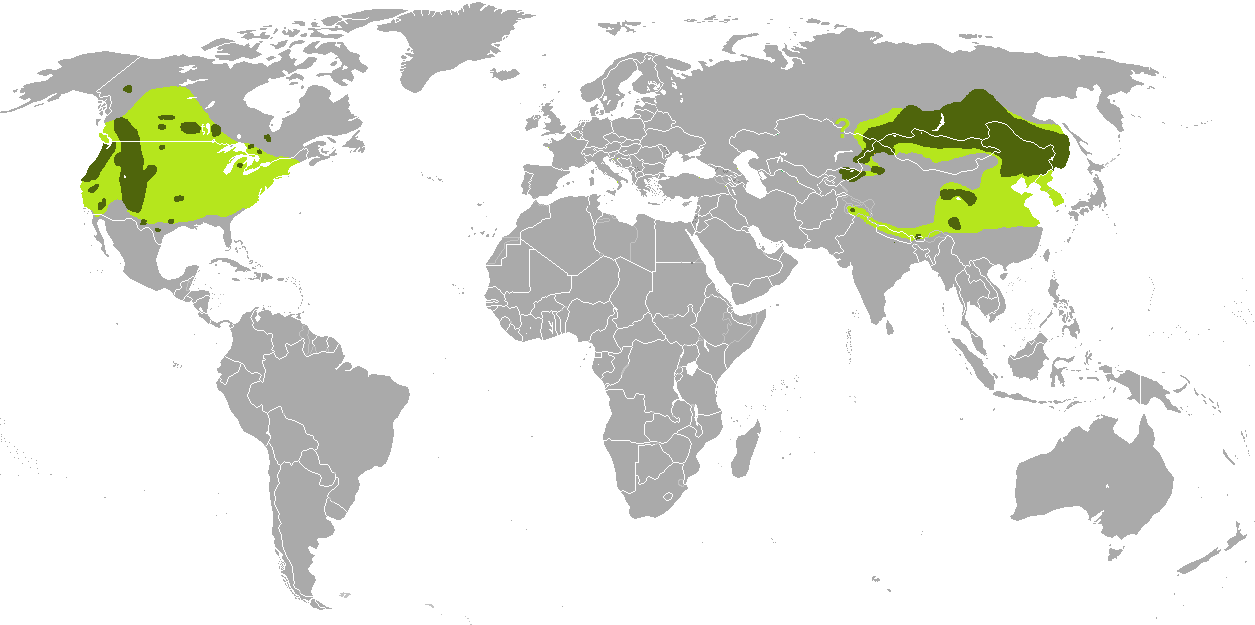


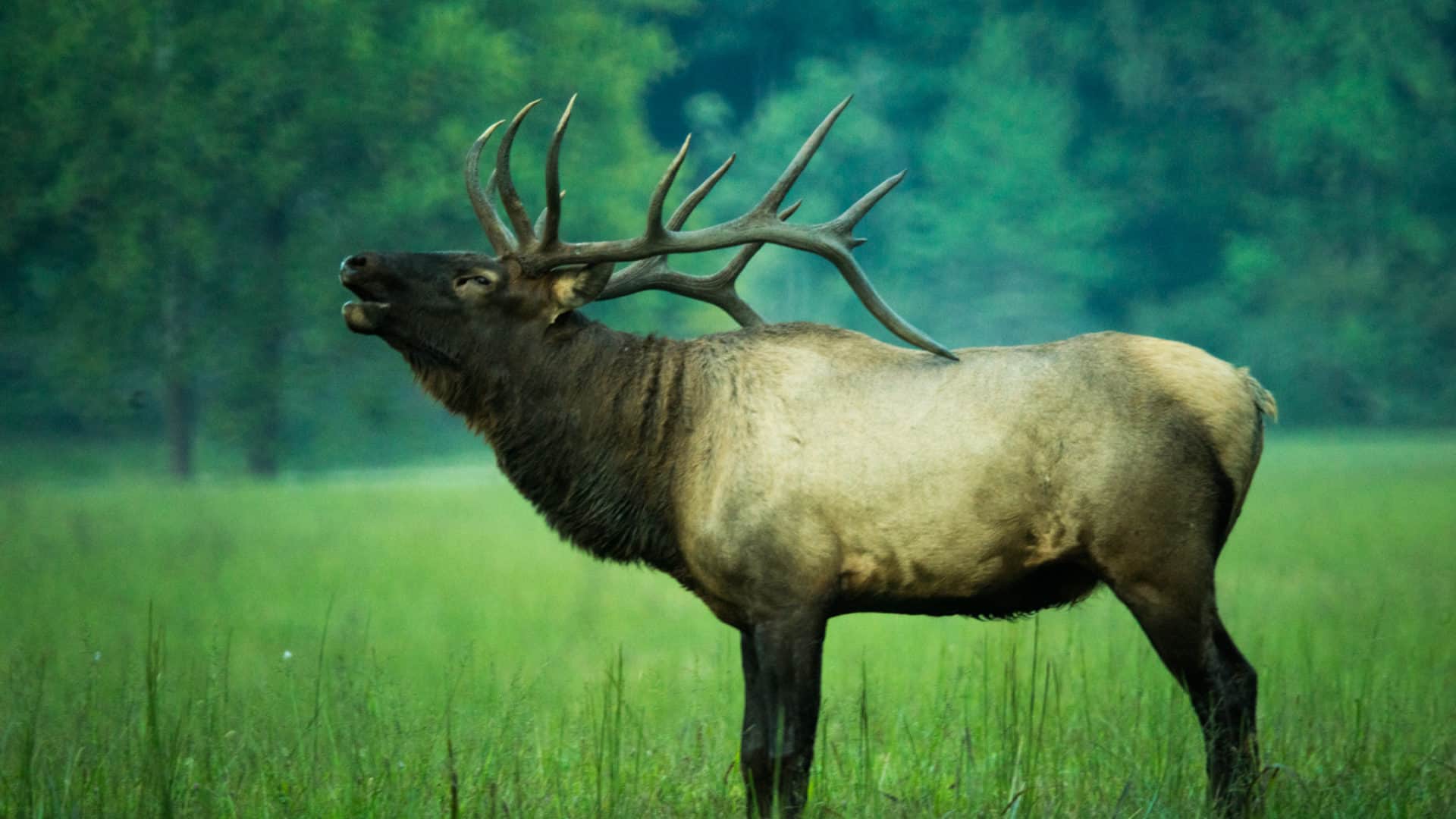
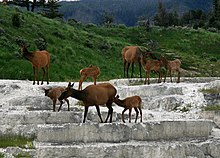


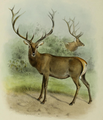

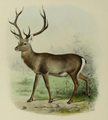






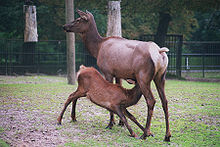
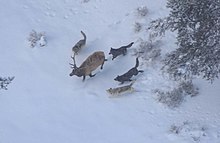








No comments:
Post a Comment
Note: Only a member of this blog may post a comment.